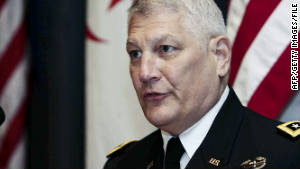By Jill Dougherty, CNN Foreign Affairs Correspondent
updated 11:16 PM EST, Fri October 14, 2011
 Gen. Carter Ham, commander of U.S. Africa Command, expressed concern that missiles are crossing Libya’s border
Gen. Carter Ham, commander of U.S. Africa Command, expressed concern that missiles are crossing Libya’s border
Washington (CNN) — An expanded team of civilian technical experts from a “quick-reaction force” is on the ground in Libya, tracking down and destroying “MANPADs,” shoulder-fired, heat-seeking missiles that the U.S. fears could be used to bring down a civilian airliner.
The United States currently has a State Department officer and 14 technical experts who are embedded with munitions and destruction teams from Libya’s National Transitional Council, according to Andrew Shapiro, assistant U.S. secretary of state for political-military affairs.
Officials hope to ramp up the search effort “significantly,” Shapiro said, with the number of specialists on the ground increasing to 50.
The joint teams are sweeping, surveying and securing stockpiles of the weapons that were previously under control of the Moammar Gadhafi regime.
The joint teams already have surveyed 20 out of 36 known ammunition storage sites, a State Department official said, and have disabled or destroyed hundreds of MANPADs. The official was not authorized to speak on the record. At each site they have found from several dozen to several hundred storage bunkers.
The United States estimates there were as many as 20,000 surface-to-air missiles in Libya when NATO began its operations to aid rebels in ousting Gadhafi.
Shapiro declined to say how many weapons might be missing, but U.S. Gen. Carter Ham, commander of U.S. Africa Command, expressed concern that the missiles could be crossing the border.
“There are some worrying indicators … that some of these portable air defense systems have left Libya,” Ham said, adding that he didn’t have enough information to know how many have possibly moved, “but there’s enough … churn out there in the information I see to cause me to be very concerned.”
U.S. officials are working with Libya’s neighbors on “how best to address this threat,” Shapiro said.
The United States is distributing thousands of pamphlets in multiple languages, including Arabic and English, to neighboring countries, including Egypt, Algeria and Morocco, to inform their border guards what the MANPADs look like and to be on watch for any attempts to move them out of Libya.
Ham noted that the MANPADs are a threat “to anything that flies,” including commercial airliners upon takeoff and landing.
The United States also is working through NATO to alert the Libyans to stockpiles NATO was aware of and may have targeted during the conflict.
“When it comes to the conventional weapons destruction challenge, the NTC have not only have talked the talk, they’ve walked the walk,” the State Department official said. “They have really taken leadership on this and we are committed to helping them secure the weapons stockpiles.”
The U.S. experts involved in the operation are mostly retired military personnel who were specialists in munitions handling and ordnance destruction at the Department of Defense, Shapiro said. Many of them work with nongovernmental organizations on de-mining. Shapiro noted the United States paid $3 million to two non-governmental organizations in Libya “to help secure weapons that they discovered.”
CNN Pentagon correspondent Barbara Starr contributed to this report






